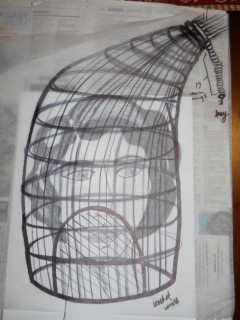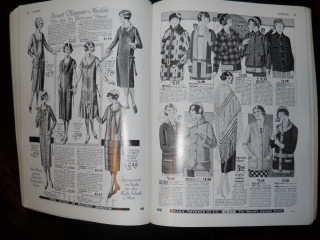Wednesday, March 23, 2011
response to cabinet color reading; color black
For this reading I do not entirely agree with the author. The author noted the color black is used to block something out . He mentions black exist " when no light is present" and stifles our true ability to see clearly. He mentions the color black comes up most in clothing to show rebellion against the normal. I never did really pick up what the writer was trying to say but for me, when someone mentions the color black, I relate it to fashion. Black seems to never go out of style. It standard in practically everyone's wardrobe and everyone's owns at least one black article of clothing. I see how the author relates black to rebellion since most artist wear it but it seems more like a crazy consequence than a silent protest against the norm. Black is that one color to that creates that overall edgy and fierce vibe to the clothing. It makes a statement without exhausting it hue or color values. It's a color that provokes sophistication, class, mystery, and slickness all in one. This color is timeless and will ever go out of style.
Wednesday, March 9, 2011
Monday, March 7, 2011
Tuesday, February 8, 2011
Aztec Culture
Art was used for religious purposes and reverence to god. Aztec art includes pottery, pictographs, tattoos, and masks. For the most part, pottery was one of the most important types of art because it showed reverence to god. Color that most commonly appear in pottery are red, white and black decorated with geometric designs. Tattoos were used in rituals to be craved by a priest on the stomach, wrist or arm of children with a pointed stone as sign of their devotion to god. Also, tattoos were a symbolized warrior accomplishments. Pictographs were used to show reference for the weigh of objects. Masks were used during rituals or ceremonies dedicated to god.
Tuesday, February 1, 2011
Response to color artist: Carter Mull
 |
| The Tar Pit |
Carter Mull
Born: Atlanta, Georgia 1977
American artist currently in Los Angeles
received BFA from Rhode Island School of Design in 2000
received MFA from California Institute of Art in 2006
Technique: photographs images and then use computer manipulation techniques to achieve highly intense colors
At first glance, Mull instantly engages the senses with his use of color. Using computer manipulation techniques, he amplifies everyday news articles into a firework spectacle. Mull stimulates the mind by feeding a shagadelic experience to the viewer from typical newspaper articles. It is as if he takes the debris from a great catastrophe and reconstructs a stunning masterpiece out of misfortune. The colors develop rhythm creating playful movement to carry the eye throughout the entire piece. Stare a little longer: an echo of a techno beat emerges then gradually intensifies as the eye begins to see the composition as a whole. Not only does Mull’s color choice serve to please, but it bares disturbing resemblance to the chaotic reality of the news. In the piece, “Passenger”, he smears the colors, magenta and violet across the headline of the Gulf oil spill, the decline of stocks and mass vehicle recalls depicting the bruises from each blow of disaster. Take a closer look and notice hidden slash marks seeping out red. Red resembles open wounds that will never heal due to society’s inability to face harsh truths. An advertisement nonchalantly rests left of the chaos, reads, “DAY SALE” serving as a distraction yet, ranks at the same importance of the hideous headlines. Mull confronts the viewer right on the spot how he tends to react to such unfortunate events – either to simply ignore or actively resolve the problem at hand. Nevertheless, Mull’s work proves: from an exhaustive period of great turmoil, beauty will surface once again.
At first glance, Mull instantly engages the senses with his use of color. Using computer manipulation techniques, he amplifies everyday news articles into a firework spectacle. Mull stimulates the mind by feeding a shagadelic experience to the viewer from typical newspaper articles. It is as if he takes the debris from a great catastrophe and reconstructs a stunning masterpiece out of misfortune. The colors develop rhythm creating playful movement to carry the eye throughout the entire piece. Stare a little longer: an echo of a techno beat emerges then gradually intensifies as the eye begins to see the composition as a whole. Not only does Mull’s color choice serve to please, but it bares disturbing resemblance to the chaotic reality of the news. In the piece, “Passenger”, he smears the colors, magenta and violet across the headline of the Gulf oil spill, the decline of stocks and mass vehicle recalls depicting the bruises from each blow of disaster. Take a closer look and notice hidden slash marks seeping out red. Red resembles open wounds that will never heal due to society’s inability to face harsh truths. An advertisement nonchalantly rests left of the chaos, reads, “DAY SALE” serving as a distraction yet, ranks at the same importance of the hideous headlines. Mull confronts the viewer right on the spot how he tends to react to such unfortunate events – either to simply ignore or actively resolve the problem at hand. Nevertheless, Mull’s work proves: from an exhaustive period of great turmoil, beauty will surface once again.
Sunday, January 2, 2011
Foundations Final Project
1 3 December 2010
Foundations
Tina Aufiero
My idea for this project derives from my HS classes. My professor introduced the writing styles of Alice Walker, Katherine Mansfield, Virginia Woolf, Derek Walcot and Thom Gunn; I took particular interest in Virginia Woolf. Upon reading Virginia Woolf’s, A Room of One’s Own, she notes how it is vital for women to have financial support in order to write, “a woman must have money and a room of her own if she is to write fiction” (4). When I read this sentence I related it to my financial situation for schooling. My struggle for an education then made me realize those women during the early 19th century fighting for equal rights and opportunities as men. In one segment of her essay, she creates a fictional character named Judith, “Shakespeare’s sister” to argue that a young woman as talented as Shakespeare was more than likely to be rejected to pursue their development as a writer,“ Meanwhile his extraordinarily gifted sister, let us suppose, remained at home. She was adventurous, as imaginative, as agog to see the world as he was. But she was not sent to school. She had no chance of learning grammar and logic, let alone reading of Horace and Virgil” (47). It was from this very passage, I felt vulnerable and hopeless but at the same time, empowered to call attention to issue. In my project I want to convey the harsh reality of equality for women. I felt the best way to translate this message is by constructing a cage as a headdress which reflects how minds were confined, denied of education and, unfortunately, even today.
On a lighter note, finding my inspiration for my headdress was quite simple. The first person to come to mind when I thought of crazy, outrageous and flamboyant style was Lady Gaga. This pop diva’s lyrics are as risky as her insane and most extraordinary clothing style.
Lady Gaga states fashion is a major influence on her music; in fact, she supervises her very own clothing production called, The Haus of Gaga. The team invents and creates from her clothes to the props on set of performances. When she writes a song, she envisions the final product and how it will amaze the fans, she says, “When I’m writing music, I’m thinking of clothes I want to wear on stage. It’s all about everything altogether – performance art, pop performance art, fashion. For me, it’s everything coming together and being a real story that I will bring back to the super-fan. I want to bring back that. I want the imagery to be strong that the fans will want to eat and taste and lick every part of us” (MTV News.com). Lady Gaga has no limitations for her designs when it comes to clothing, therefore, after viewing pictures of outfits I felt more comfortable inventing a design. When mentioning Lady Gaga as one source of my inspiration, a student then suggested I research Isabella Blow. Isabella Blow noted fashion editor and international fashion icon but mostly known for her array of ridiculous hats and headdresses. Her obsession began when she befriended designer, Philip Treacy, who designed the wedding veils for her second wedding. Soon after that, Blow took him under her wing and promoted his designs by wearing his hats. She claims she wore the hats to keep sane and to everyone away from her, she once said “Fashion is a vampiric thing. It’s the hoover on your brain. That’s why I wear the hats, to keep everyone away from me. They say, “Oh, can I kiss you? I say “No, thank you very much. That’s why I’ve worn the hat. Goodbye.” I don’t want to be kissed by all and sundry. I want to be kissed by people I love” ( Guardian.co.uk).
Subscribe to:
Comments (Atom)






























